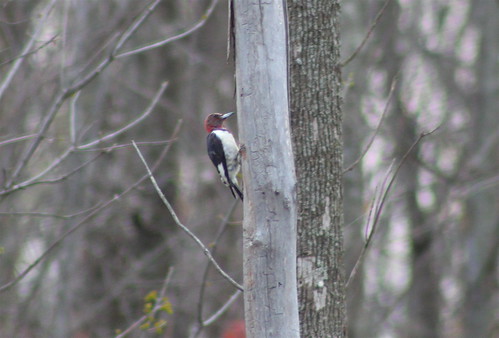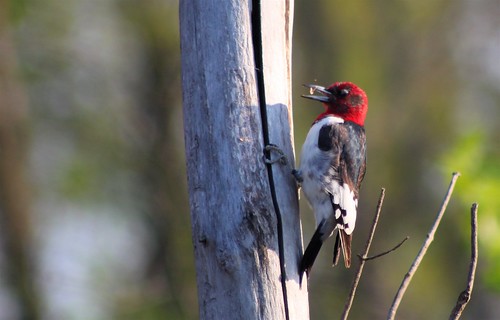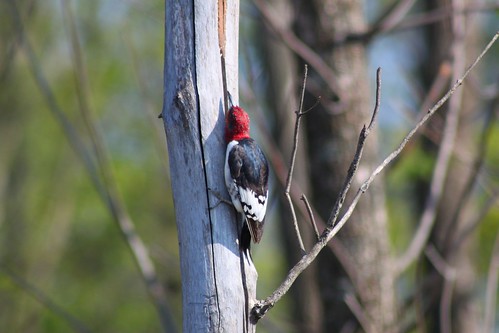I got up close and personal with an immature Red-headed Woodpecker yesterday. He was fine with me photographing and videoing him from about 10 feet away. I think he was so engrossed in what he was doing that he didn't even notice me there.
I know this guy is an immature because I've been seeing him for some time and he has gone from having a completely brown head to a mostly red head now. Most birds go through two molts a year, usually before and after breeding. The spring molt is called the "alternate" molt because only certain feathers are replaced, namely the colorful feathers used to attract mates. After a long summer of breeding, a majority of birds molt into their "basic" plumage, which is less colorful but helps camouflage the bird since nice bright feathers are no longer needed to attract mates. Molting is important because it replaces old worn feathers that would not be suitable for traversing the hundreds of miles most birds fly in the spring and fall.
Here is what he looked like at the beginning of the month. This photo was taken on April 8th...
And this is what he looks like now. Almost all his head feathers are replaced, just the patch on his cheek and a few strays before his head will be completely red.
He was hammering away at the tree, throwing sawdust to the side and scarfing any bugs or seeds he could find.
I thought this shot was comical. He was scooting up the tree and using his rectrices (tail feathers) to prop himself up. All woodpeckers have stiff tail feathers that are used for propping themselves up while they climb trees. Most birds replace their tail feathers starting with the innermost feathers and work their way out toward the outer tail feathers. Interestingly, woodpeckers have evolved to do just the opposite. They molt their outer tail feathers first and replace their central tail feathers last. The reason for this is because their inner tail feathers are the strongest and are the main way woodpeckers move around on trees. By molting them last they retain this ability until all the outer feathers are replaced and can compensate for their central tail feathers in keeping them propped up against tree trunks.
I was able to take a couple videos of him while he worked on the tree snag. The footage is a bit shaky because I was hand holding the camera so I apologize if you get dizzy watching. Extra points if you can name me some of the birds heard in the background. I tell you what, be the first to name a bird you hear in the background and I will send you a free 4x6 print. Leave a comment by clicking the "comments" button underneath the title of the post or by clicking here.



 7:22 PM
7:22 PM







 Posted in:
Posted in: 




25 comments:
Nice article! I have been curious lately about molting! The videos are great! It just looks so funny to me to see them pecking so hard! It seems like they would have a constant headache!
Incredible photos,and interesting facts! The video is pretty good too!
What a great blog... I've only read a few posts so far, but learning a lot! The woodpecker photos and video are wonderful. Thanks for sharing and for the effort you are pouring into this resource.
Gorgeous captures and great post of wonderful info. Nice to find you!
A real beauty with that red head.
Never seen these before, and the video made it all the more interesting for me.
Great close ups. Boom & Gary of the Vermilon River, Canada.
Superb post! That was new information for me on how woodpecker tail feathers molt. What an amazing easy going and informative essay to accompany your spectacular photography. I so badly want to see a Red-headed woodpecker one day. I really appreciate seeing yours.
By the way, I heard a robin and a Boing 727!
Wonderful videos and pictures to me. There is no such a bird in our country - so I enjoy very much your beautiful shots and videos
Beautiful images and very educating videos. Well done and thank you.
Super post. Loved the videos.
Great photos and very interesting details about the moult of the bird. It's very interesting also to see how quickly the head color has changed.
Great photos! Its a very beautyful bird!
Great sighting and a beautiful woodpecker. Wonderful photos.
Great post of the history of this bird. It is always fun to get to know individual birds.
Great information to accompany those terrific photos.
Lovely images of your beautiful Woodpecker. Many thanks for sharing.
Excellent series on the Red-headed Woodpecker! The videos are awesome!
Informative narrative and great photos! Loved the videos showing him working that snag!
he's beautiful! great shots!
Oh my this is beautiful!!
WBW
Great photos of the Red-headed Woodpecker. Bob
Thanks all for the comments. Springman named one bird heard in the background, anyone else care to make a guess?
wow what a great series of the Red Head!! HE is a beauty...and I really enjoyed the videos---
What a lovely bird -- and really nice captures of it! Thanks for including the videos too, it's great to see them in action!
Darn- the robin was the one I heard. This is so much easier when I hear the birds in my neck of the woods!
Post a Comment